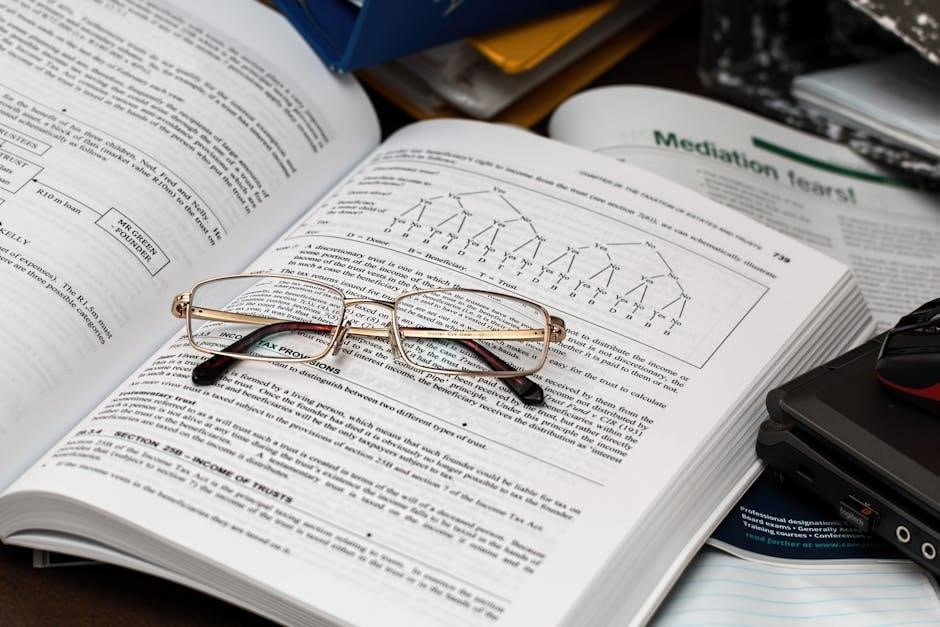Math 30-2 focuses on logical reasoning, set theory, probability, and polynomial functions. The official textbook covers these topics, with Unit 7 offering additional resources and homework solutions.
1.1 Overview of the Course Structure
Math 30-2 is structured into five main units: Logic and Set Theory, Permutations and Combinations, Probability, Rational Expressions, and Polynomial Functions. Each unit builds on foundational concepts, with Unit 1 introducing logical reasoning and set operations. The course progresses to probability theory and practical applications, followed by rational expressions and polynomial functions. Additional resources, such as PDF textbooks and online tutorials, are available to supplement learning. The diploma exam accounts for 30% of the final mark, emphasizing the importance of thorough preparation and understanding of all units. Self-study strategies and digital tools are encouraged for success.
1.2 Importance of Logic and Set Theory in Math 30-2
Logic and Set Theory are foundational to Math 30-2, providing essential tools for problem-solving and analytical thinking. These concepts underpin probability, permutations, and polynomial functions, making them crucial for understanding advanced topics. Set Theory introduces operations like union and intersection, while logical reasoning enhances deductive skills. Resources like PDF textbooks and online tutorials emphasize these areas, ensuring students grasp fundamental principles. Mastery of these concepts is vital for success in subsequent units and the diploma exam, as they form the backbone of mathematical reasoning and practical application.

Unit 1: Logic and Set Theory
Unit 1 introduces logical reasoning and set theory, foundational concepts for problem-solving. It covers set operations and logical arguments, essential for understanding later units and real-world applications.
2.1 Key Concepts in Logical Reasoning
Logical reasoning in Math 30-2 involves understanding arguments, statements, and truth values. Students learn to identify valid and invalid reasoning patterns, including tautologies and contradictions. Key concepts include propositions, logical connectives, and truth tables. These tools enable problem-solving and critical thinking. The textbook emphasizes analyzing arguments, identifying fallacies, and constructing logical proofs. These skills are essential for real-world applications and higher-level mathematics. By mastering logical reasoning, students build a strong foundation for advanced problem-solving and analytical thinking.
Set theory introduces fundamental concepts such as elements, sets, and subsets. Students learn to define sets using roster and descriptive methods. Basic operations include union, intersection, complement, and difference. Venn diagrams are used to visualize relationships between sets. The textbook emphasizes solving problems involving set operations and understanding De Morgan’s laws. These concepts form the basis for advanced mathematical analysis and problem-solving. Mastering set theory is crucial for tackling more complex topics in subsequent units, such as probability and combinatorics.

Unit 2: Permutations and Combinations
Unit 2 explores permutations and combinations, focusing on arrangements and selections of objects. It covers factorial calculations, distinguishing between ordered and unordered outcomes, and practical applications.
3.1 Understanding Permutations and Their Applications
Permutations involve arranging objects in specific orders, calculated using factorials. They distinguish between ordered outcomes, unlike combinations. Applications include password creation, scheduling, and real-world problem-solving, making permutations essential in probability and combinatorics for understanding unique arrangements and their practical uses.
3.2 Combinatorial Analysis and Problem-Solving Strategies
Combinatorial analysis involves counting and arranging objects to solve complex problems. Strategies include systematic counting, identifying patterns, and using combinations. These methods are essential for probability, resource allocation, and real-world scenarios. By mastering these techniques, students can approach problems logically and efficiently, ensuring accurate solutions in various mathematical contexts.

Unit 3: Probability
Unit 3 introduces probability fundamentals, including theoretical concepts and practical applications. Students learn to calculate probabilities in real-world scenarios, enhancing their analytical and problem-solving skills effectively.
4.1 Fundamentals of Probability Theory
This section introduces core probability concepts, including probability rules, sample spaces, and Venn diagrams. Students explore theoretical probability, conditional probability, and independent events. Key topics include calculating probabilities for single and multiple events, understanding mutually exclusive outcomes, and applying probability rules to real-world problems. The textbook provides detailed examples and exercises to reinforce these concepts, ensuring a solid foundation for further probability applications. Resources like Unit 3 notes and homework solutions aid in mastering these fundamental principles.
4.2 Calculating Probability in Real-World Scenarios
This section applies probability theory to practical situations, such as finance, genetics, and everyday decision-making. Students learn to calculate probabilities for real-world events, including combinatorial probabilities and conditional probabilities. The textbook provides exercises on topics like drawing cards, rolling dice, and genetic inheritance. These problems help students understand how to apply probability to predict outcomes and make informed decisions. Additional resources, such as homework solutions and notes, support practice in solving these types of problems effectively.

Unit 4: Rational Expressions
This unit covers simplifying rational expressions, solving equations, and inequalities involving rational expressions. It emphasizes practical applications and problem-solving strategies to master these mathematical concepts effectively.
5.1 Simplifying and Manipulating Rational Expressions
This section focuses on simplifying rational expressions by factoring and canceling common terms. It covers identifying restrictions, simplifying complex fractions, and manipulating expressions for equations and inequalities. Students learn to factor polynomials, reduce expressions, and handle exponents. Practical applications and problem-solving strategies are emphasized to ensure mastery of rational expressions. The official textbook provides detailed examples and exercises to reinforce these concepts, making it easier for students to apply them in real-world scenarios and prepare for assessments.
5.2 Solving Equations and Inequalities Involving Rational Expressions
This section teaches students to solve equations and inequalities containing rational expressions. Key steps include identifying restrictions, cross-multiplying to eliminate denominators, and solving the resulting equations. Special attention is given to inequalities, where flipping the inequality sign is crucial when multiplying by negative numbers. The textbook provides examples and exercises to practice these skills, ensuring students can apply them confidently in various mathematical and real-world scenarios, preparing them for more complex problem-solving tasks.

Unit 5: Polynomial Functions
Unit 5 focuses on polynomial functions, exploring their properties, graphs, and operations. The textbook provides detailed lessons and resources, including homework solutions and notes in PDF format, to master these concepts effectively.
6.1 Properties and Graphs of Polynomial Functions
Polynomial functions are central to Unit 5, focusing on their degree, leading coefficients, and end behavior. The textbook explains how to analyze graphs, identifying key features like intercepts and turning points. Students learn to sketch graphs by examining coefficients and roots, understanding how transformations alter shapes. Practice exercises and solutions in the PDF resources help reinforce these concepts, ensuring a solid foundation for further polynomial operations and applications in real-world scenarios.
6.2 Polynomial Operations and Applications
Unit 5 delves into polynomial operations, including addition, subtraction, and multiplication. The textbook guides students through factoring techniques and polynomial division, essential for simplifying expressions; Applications in modeling real-world problems, such as population growth and geometric shapes, are emphasized. Homework solutions in the PDF resources provide clear examples, helping students master these skills and apply them to practical scenarios, reinforcing their understanding of polynomial functions and their diverse uses in mathematics.

Additional Resources for Math 30-2
Official textbooks and study guides provide comprehensive coverage of Math 30-2 topics. Additional resources include online PDF files, such as Unit 7 materials and homework solutions, available for free download.
7.1 Official Textbooks and Study Guides
Official Math 30-2 textbooks provide a comprehensive overview of the curriculum, covering logical reasoning, set theory, probability, and polynomial functions. These resources are designed to align with the course outcomes and include detailed explanations, examples, and practice problems.
Study guides often accompany the textbooks, offering additional support for complex topics like permutations, combinations, and rational expressions. Many of these materials are available as downloadable PDFs, making them accessible for self-study and review.
7.2 Online Resources and Video Tutorials
Supplement your learning with online resources and video tutorials designed for Math 30-2. Websites like YouTube and educational platforms offer detailed explanations of key concepts, such as set theory and probability. Tutorials often include step-by-step solutions to practice problems, helping you grasp complex topics like permutations and combinations. Additionally, interactive tools and forums provide opportunities to ask questions and discuss challenges with peers and instructors. These resources are particularly useful for self-study and reinforcing concepts covered in the official textbook.

Diploma Exam Preparation
The diploma exam accounts for 30% of the final mark. Resources like past papers and video tutorials help students prepare effectively for the assessment.
8.1 Exam Specifications and Weightage
The Math 30-2 diploma exam consists of 32 machine-scored questions (75%) and 24 multiple-choice questions (25%). It assesses logical reasoning, probability, and polynomial functions. The exam is 2 hours long, and calculators are not permitted. Resources like past papers and study guides are available for preparation. Understanding the weightage of each section helps students focus their study efforts effectively. The exam is worth 30% of the final course mark. Proper time management and practice are key to success.
8.2 Tips for Success in the Math 30-2 Diploma Exam
To excel in the Math 30-2 diploma exam, start by thoroughly understanding the course material, especially logic, probability, and polynomial functions. Practice past exam papers to familiarize yourself with the format and time constraints. Focus on weak areas and review mistakes to avoid repeating them. Utilize official study guides and online resources for additional practice. Develop a study schedule to cover all units evenly. Stay calm during the exam, read questions carefully, and manage your time effectively. Seeking help from teachers or tutors can also enhance your preparation.

Self-Study Strategies for Math 30-2
Utilize the official Math 30-2 textbook and online resources for structured learning. Create a study schedule and practice regularly to master concepts independently.
9.1 Effective Learning Techniques for Independent Study
For successful independent study in Math 30-2, establish a structured schedule and break study sessions into manageable parts. Utilize the official textbook and available PDF resources, such as Unit 7 materials, to guide your learning. Practice regularly with provided homework solutions and notes. Engage in self-assessment by solving problems and reviewing answers. Leverage online tutorials and video resources to clarify complex topics. Seek clarification on difficult concepts through online forums or study groups to ensure understanding and progress.
9.2 Utilizing Digital Tools for Math Practice
Digital tools enhance Math 30-2 study by providing interactive resources and practice materials. Utilize online platforms offering video tutorials, such as those mentioned in Unit 7, to supplement textbook learning. Downloadable PDFs, like homework solutions and notes, aid in self-study and exam preparation. Additionally, explore apps and websites for interactive math exercises. Tools like Khan Academy and Wolfram Alpha can help visualize concepts and solve problems step-by-step. Regular use of these tools fosters a deeper understanding and improves problem-solving skills, making independent study more efficient and effective.




Leave a Reply
You must be logged in to post a comment.